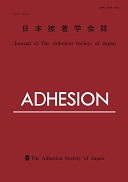
- |<
- <
- 1
- >
- >|
-
Hyun-Joong Kim2017Volume 53Issue 3 Pages 93-101
Published: March 01, 2017
Released on J-STAGE: September 11, 2018
JOURNAL FREE ACCESSDownload PDF (2243K)
-
Soichi TANAKA2017Volume 53Issue 3 Pages 89-92
Published: March 01, 2017
Released on J-STAGE: September 11, 2018
JOURNAL FREE ACCESSDownload PDF (1712K)
-
Shiho KUWASHIRO, Nozomu NAKAO, Satoshi MATSUDA, Hajime KISHI2017Volume 53Issue 3 Pages 83-88
Published: March 01, 2017
Released on J-STAGE: September 11, 2018
JOURNAL FREE ACCESSIt is expected to apply carbon fiber reinforced thermoplastics to industrial fields widely because ofsecondary remoldablity as well as light-weight and high-strength. The authors has developed thecarbon fiber reinforced acrylic composites with good adhesion between fibers and matrix and highstrength by copolymerizing the functional monomers to matrix resin. In this paper the effect of thecopolymerization of hydroxyethylacrylamide(HEAA)on the fatigue life of carbon fiber woven cloth/acrylic resin laminates was investigated. The shear adhesion tests showed that interfacial strengthbetween carbon fibers and matrix copolymer increased with increasing the content of HEAA. Thestronger interfacial strength gave the higher flexural strength of the composites, which is equivalentto that of the conventional carbon fiber/epoxy laminates. As a result of the fatigue tests, the fatiguelife became longer as copolymerization ratio increased. In-situ observation revealed that the copolymerizationof HEAA prevented the crack growth rather than the crack formation.
View full abstractDownload PDF (4061K)
-
Toshiaki OUGIZAWA, Yuki MISHIMA, Hiroaki IIKURA2017Volume 53Issue 3 Pages 77-82
Published: March 01, 2017
Released on J-STAGE: September 06, 2018
JOURNAL FREE ACCESSThe interfacial thickness between different polymers depends on miscibility. Especially the interactionparameter x which dominate miscibility between different polymers can be estimated from theequilibrium interfacial thickness in immiscible polymer pair. Usually because the interfacial thicknessbetween immiscible polymers is very thin, the adhesion strength is very low. We measured the interfaceformation process in spin-coating samples by a high-speed ellipsometer and observed a behaviorthat interfacial thickness increased suddenly. This behavior occurred in a temperature less than Tg ofbulk and showed a large increasing speed of interfacial thickness. Moreover, an interfacial thicknessformed by this behavior reached several times of the equilibrium interfacial thickness in immisciblesystems. We applied this behavior to adhesion between immiscible polymers and succeeded in obtainingstrong adhesion.
View full abstractDownload PDF (1627K)
- |<
- <
- 1
- >
- >|